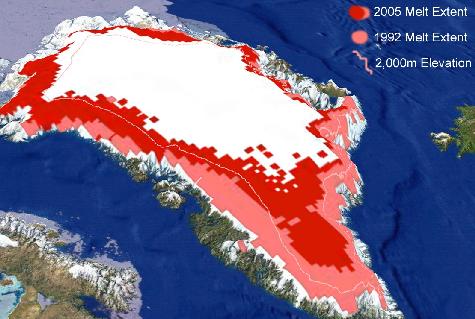(CNN) -- Between 1.5 trillion and 2 trillion tons of ice in Greenland, Antarctica and Alaska has melted at an accelerating rate since 2003, according to NASA scientists, in the latest signs of what they say is global warming.
Using new satellite technology that measures changes in mass in mountain glaciers and ice sheets, NASA geophysicist Scott Luthcke concluded that the losses amounted to enough water to fill the Chesapeake Bay 21 times.
"The ice tells us in a very real way how the climate is changing," said Luthcke, who will present his findings this week at the American Geophysical Union conference in San Francisco, California.
NASA's Gravity Recovery and Climate Experiment, or GRACE, mission uses two orbiting satellites to measure the "mass balance" of a glacier, or the net annual difference between ice accumulation and ice loss.
"A few degrees of change [in temperature] can increase the amount of mass loss, and that contributes to sea level rise and changes in ocean current," Luthcke said.
The data reflects findings from NASA colleague Jay Zwally, who uses different satellite technology to observe changing ice volume in Greenland, the Arctic and Antarctica.
In the past five years, Greenland has lost between 150 gigatons and 160 gigatons each year, (one gigaton equals one billion tons) or enough to raise global sea levels about .5 mm per year, said Zwally, who will also present his findings at the conference this week.
Ice melting across globe at accelerating rate, NASA says - CNN.com
Using new satellite technology that measures changes in mass in mountain glaciers and ice sheets, NASA geophysicist Scott Luthcke concluded that the losses amounted to enough water to fill the Chesapeake Bay 21 times.
"The ice tells us in a very real way how the climate is changing," said Luthcke, who will present his findings this week at the American Geophysical Union conference in San Francisco, California.
NASA's Gravity Recovery and Climate Experiment, or GRACE, mission uses two orbiting satellites to measure the "mass balance" of a glacier, or the net annual difference between ice accumulation and ice loss.
"A few degrees of change [in temperature] can increase the amount of mass loss, and that contributes to sea level rise and changes in ocean current," Luthcke said.
The data reflects findings from NASA colleague Jay Zwally, who uses different satellite technology to observe changing ice volume in Greenland, the Arctic and Antarctica.
In the past five years, Greenland has lost between 150 gigatons and 160 gigatons each year, (one gigaton equals one billion tons) or enough to raise global sea levels about .5 mm per year, said Zwally, who will also present his findings at the conference this week.
Ice melting across globe at accelerating rate, NASA says - CNN.com
Last edited:
